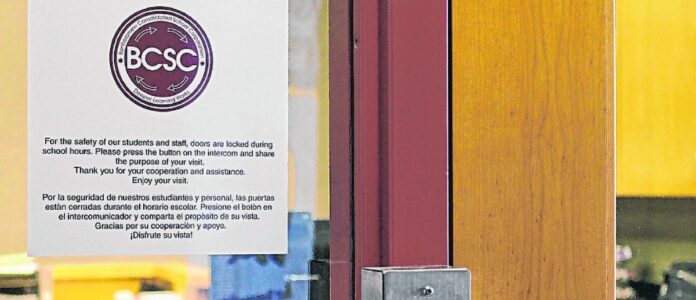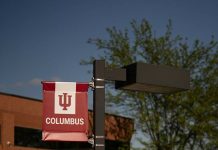
Bartholomew Consolidated School Corp. Superintendent Jim Roberts wishes he could guarantee the safety of each student and adult who walks through the doors of one of the corporation’s 21 buildings every day.
But he can’t.
“I can ensure people that we are doing everything possible to take care of the students and adults in our school corporation — that’s 21 buildings we have, including 18 school buildings and three others with adults only in them,” said Roberts, who is in his third year as superintendent of the district.
Every day, about 13,500 people walk through the doors of one of BCSC’s 21 buildings. Roberts said his greatest priority is the supervision, safety and security that the community provides to every student and staff member.
[sc:text-divider text-divider-title=”Story continues below gallery” ]
“Every day we take a look at opportunities to get better at providing safety for our kids and staff members,” Roberts said. “I hate not being able to guarantee anything, but I’m not sure how many guarantees there truly are in life. When we leave home in the morning, there are no guarantees. I understand our responsibility. I know what that is, and we’re going to accept it and do the best we can.”
In 2012, before Roberts’ arrival at BCSC, measures were taken to strengthen building security across the district following the tragedy at Sandy Hook Elementary School. The Sandy Hook shooting occurred Dec. 14, 2012, in Newtown, Connecticut, when a 20-year-old man shot and killed 26 people, including 20 children between the ages of 6 and 7 years old, and six adult staff members at the school.
Part of BCSC’s efforts included installing stronger glass at various BCSC buildings, creating single points of entry and installing new cameras.
A year ago, in Roberts’ second year at the school corporation, the corporation took time to look at what had been done and what could be done to move forward following the Feb. 14, 2018, shooting at a high school in Parkland, Florida.
Bartholomew County schools experienced at least eight school safety threats since the Parkland shooting.
“I would categorize our efforts in two ways,” Roberts said. “One had been just about making things feel more safe and secure from a hardening of the building standpoint and the provision of more people to help out from a safety and security standpoint.”
This includes the addition of three new school resource officers in addition to the two who currently serve BCSC schools. Beginning this fall, Columbus Police Sgt. Julie Quesenbery will oversee all BCSC school resource officers.
Quesenbery, who currently serves seven BCSC schools, said the need for these additional officers was apparent from the beginning.
“When this program started in 2014, we met a year after that in 2015 (to evaluate the program),” Quesenbery said. “My answer was, ‘We need more resource officers.’”
At that point, she and another officer each oversaw nine schools.
“That’s a lot,” Quesenbery said. “You get run ragged in a day, and not only that, but kids aren’t getting what they need because I’m running from this kid to the other kid, and I want to be able to build these relationships and have important conversations with them.”
Adding more officers
BCSC added a third school resource officer in January, and two more officers will join the school resource officer force when school begins in August. At that time, Quesenbery will transition to overseeing two schools and the school resource officer program.
“I’m so thankful the community saw a need for that,” she said. “It’s going to be awesome to have officers in and out of the schools where it won’t be weird for students to see officers and have interactions and have them as a resource, day in and day out.”
Beyond building relationships, the school resource officer is also one of the first to respond to incidents, including the two threats that occurred at Columbus East High School just days after the incident in Parkland.
“As soon as the information came to me, I let a few officers know that needed to know in order to track the source down very quickly,” Quesenbery said, describing her response to threats when they come in.
“They were both brought to a pretty quick resolve and that’s because we have training and we are put in these positions after we’ve received training and after we’ve had years of experience on the road so we’re not like security guards here.”
She said it’s all about flipping a switch and going into action — but it’s not just on her.
“It takes all of us to keep this building safe,” she said. “I’m very quick to remind students that there’s a lot more of you than there is of me. Believe me, I’m walking around. I’m keeping an eye on things. I do. But if they see something, they need to say something. And let someone know what’s going on.”
Roberts said he thinks most people in the community are focused on a building’s physical security, but what he says will have the most lasting influence is how the corporation meets the mental health needs of its students.
To do this, the corporation relies on the 40 developmental assets framework, which are 40 research-based, positive experiences and qualities that influence a young person’s development, according to the Search Institute, a nonprofit organization that founded the developmental assets framework.
Half of the assets focus on relationships and opportunities that are necessary through family, school and community. The other set of assets are dedicated to social-emotional strengths, values and commitments.
Student assistance coordinator Larry Perkinson said the more assets a student has, the better he or she is at finding success and controlling their emotions to make good decisions.
“We’re a community that recognizes that there are developmental assets — that if we can connect with kids, if we can provide someone they’ll talk to, if they learn to trust teachers, if we can develop those assets that allow them to trust teachers, the neighborhood, the community,” Perkinson said. “School’s not just about school grounds. It’s about who in our community is going to respond to take care of us.”
Youth with more assets are more likely to do well in school, be civically engaged and value diversity. They are least likely to have problems with alcohol use, violence, illicit drug use and sexual activity, according to the Search Institute.
Additional measures
The BCSC school board approved a measure in April to transition the district’s three high schools from a traditional schedule to a block schedule beginning in the 2020-21 school year. A block schedule means students would alternate different classes between two days with longer class periods. Teachers would also have a planning period built into the schedule each week.
The proposal would implement a “Block 8” schedule — different 85-minute classes on day one and different 85-minute classes on day two with an advisory time for one day and a student resource time on the other. The schedules then continue to alternate.
During a 30-minute advisory time in the block schedule, according to a sample schedule provided by the district on March 4, students and teachers would meet to focus on BCSC’s identified 40 development assets and social emotional learning goals. The 30-minute student resource time would allow students to incorporate individual study time into their day, school officials said. Students could also use this time to meet individually with a teacher for additional help.
Columbus North principal David Clark stressed in a March 4 presentation that a block schedule is not only about getting more content into longer class periods, but is also about helping students through social and emotional learning opportunities.
The corporation also received a $1.1 million grant from the Lilly Endowment in 2017 to help students dealing with a variety of social issues. The funding allowed the district to develop a two-tiered approach focused on prevention and providing acute care to students in pre-kindergarten through 12th grade in conjunction with community health partners.
The program involves identifying students who might be dealing with problems, removing barriers that impede mental health wellness, monitoring the services that are provided and empowering students to address mental health issues and remove the stigmas that surround the conversation.
Perkinson said the corporation identified areas where they could use assistance using the Indiana Kids Count data, an in-depth profile of Indiana’s youth completed by the Indiana Youth Institute. The data is centered on four key areas, including family and community, health, economic well-being and education.
“Whether it’s a shooting threat or tornado or car accidents, we have families that have been traumatized or families that incur that secondary trauma when you know somebody else so well, but they want their kids safe and they want to be assured,” Perkinson said. “I think what we can assure them is that school is the safest place we can make it. We work on that every day.”
Roberts acknowledged that the number of threats toward the corporation since February 2018 is high but said he’s not sure it’s too much out of line with other corporations due to the presence of social media and the so-called “copycat effect,” or “a crime whose occurrence or form is influenced by prior exposure to media content and/or live criminal models,” according to University of Central Florida criminologist Ray Surette’s article titled, “Copycat Crime.”
“We’ve worked hard of trying to make sure — from a safety strategy standpoint — that anybody, students or adults, if they see something, say something,” Roberts said. “Our kids are doing a great job of that. They are saying something, even when the threat might not seem so credible. They’re saying something anyway, so we can take it seriously.”
[sc:pullout-title pullout-title=”About Taking Action” ][sc:pullout-text-begin]
This series about school safety was completed by Columbus Republic reporter Shelby Mullis as her senior project at Franklin College.
The project won the Pulliam School of Journalism Senior Achievement Award at the college.
[sc:pullout-text-end][sc:pullout-title pullout-title=”BCSC school threats” ][sc:pullout-text-begin]
There have been eight school threats reported in Bartholomew County schools since 2018.
The most recent was in February 2019 when Columbus police were told of an an alleged school threat on social media involving a Northside Middle School student.
The threat, made through a FaceTime phone call via Snapchat was from an unidentified person who said in vague terms that harm would come to people at school, school officials told police. The Northside student told the caller that he didn’t know who the student was, or which school he attended, Burnett said, and that the caller replied that it didn’t matter and the caller would find out. No arrest has been made in that case and nothing occurred as a result of that call.
In 2018, two threats were reported at Columbus North, two reported at Columbus East, two at Hauser High School in Hope and one at the Simon Youth Academy in Edinburgh. All but two of them occurred within a week of the Feb. 14, 2018, school shootings at Marjory Stoneman Douglas High School in Parkland, Florida, where 17 people died.
[sc:pullout-text-end][sc:pullout-title pullout-title=”How to subscribe to E-alerts” ][sc:pullout-text-begin]
To subscribe to receive e-alerts from Bartholomew Consolidated School Corp., go online at bcsc.k12.in.us/Page/16874.
[sc:pullout-text-end][sc:pullout-title pullout-title=”BCSC safety investments” ][sc:pullout-text-begin]
Bartholomew Consolidated School Corp. implemented new school entryway security measures in 2018 designed to protect students and staff from anyone attempting to enter the school without authorization.
Secure vestibules are now in place at all BCSC school buildings, requiring visitors to undergo background checks before entering a building. Doors that lead into school hallways and the main office are locked when a guest enters the building. A visitor seeking access is required to press an intercom button from a vestibule that would allow them to speak to someone in the main office.
Visitors go through a vetting process that includes background checks using a person’s identification card — such as a driver’s license. That background check will be similar to what the district already uses to evaluate teachers and staff members it hires.
The background check, which takes only a few minutes has the capability to pull a person’s criminal history, including whether the individual is on the state’s sex-offender registry.
BCSC spent about $70,000 in 2018 on security changes such as hardware and software, door locks and cameras. That is on top of $2 million that has been spent since 2013.
BCSC budgeted $250,000 to add three new school resource officers in 2019.
The district also ordered 46 hand-held metal detectors in 2018 from the state of Indiana, which provided them free.
[sc:pullout-text-end][sc:pullout-title pullout-title=”For more” ][sc:pullout-text-begin]
For a video that accompanies this report, visit https://youtu.be/jQgYJE0UKLM.
[sc:pullout-text-end]




